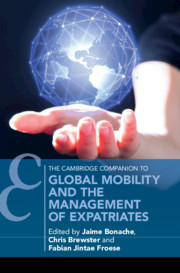Book contents
- Global Mobility and the Management of Expatriates
- Cambridge Companions to Management
- Global Mobility and the Management of Expatriates
- Copyright page
- Contents
- Figures
- Tables
- Contributors
- 1 Global Mobility
- Part I The Expatriation Process of Corporate Expatriates
- 2 The Recruitment, Selection, and Preparation of Expatriates
- 3 Expatriate Adjustment
- 4 Performance Management for Expatriates
- 5 Compensating Global Mobility
- 6 Repatriation and Career Development
- Part II Different Types of Expatriates and Stakeholders
- Index
- References
2 - The Recruitment, Selection, and Preparation of Expatriates
from Part I - The Expatriation Process of Corporate Expatriates
Published online by Cambridge University Press: 12 November 2020
- Global Mobility and the Management of Expatriates
- Cambridge Companions to Management
- Global Mobility and the Management of Expatriates
- Copyright page
- Contents
- Figures
- Tables
- Contributors
- 1 Global Mobility
- Part I The Expatriation Process of Corporate Expatriates
- 2 The Recruitment, Selection, and Preparation of Expatriates
- 3 Expatriate Adjustment
- 4 Performance Management for Expatriates
- 5 Compensating Global Mobility
- 6 Repatriation and Career Development
- Part II Different Types of Expatriates and Stakeholders
- Index
- References
Summary
This chapter discusses expatriate recruitment sources, methods, and the expatriates’ motivations to work abroad. Then it examines expatriate selection criteria, methods, and how expatriates are selected in practice. The chapter also presents the variety of expatriate preparation methods, discusses expatriate training effectiveness, and expatriate preparation in practice. It concludes by considering future avenues of research. Overall, in the area of selection and preparation for international assignments there is good material for researchers to build on and a growing understanding of the key issues. Nevertheless, there remains here a rich field for exciting research in the future.
- Type
- Chapter
- Information
- Global Mobility and the Management of Expatriates , pp. 31 - 56Publisher: Cambridge University PressPrint publication year: 2020



